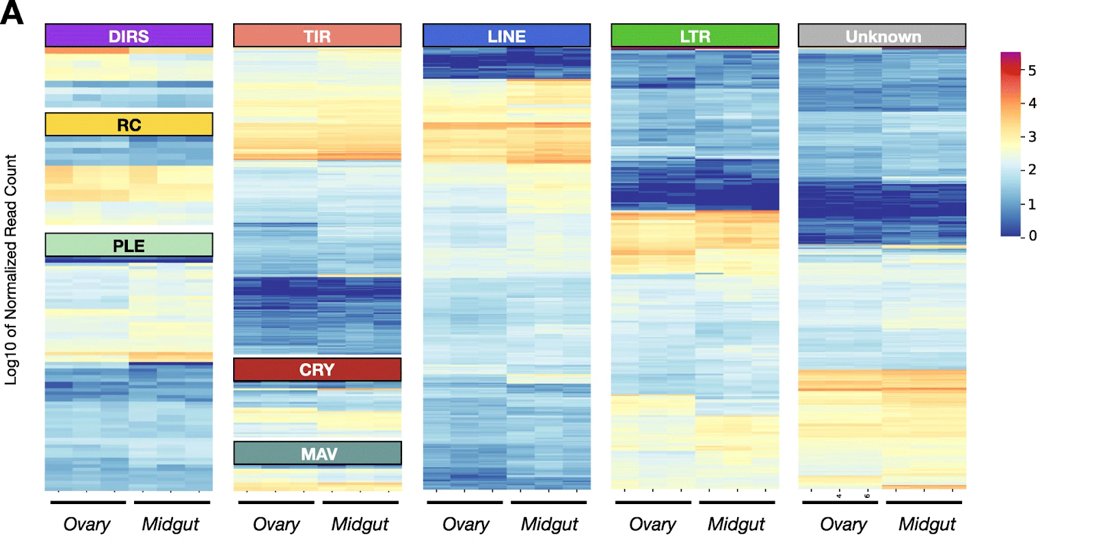
⭐️ It is with immense pleasure that we share with you the published #Sitophilus oryzae #genome paper in @BMCBiology doi.org/10.1186/s12915… 1/n
S. oryzae is a #coleopteran capable of destroying entire cereal crops posing a significant threat to the food security of many developing countries. The female #weevil lays ~300 eggs during its lifetime. They develop within the cereal grain until a ~3 day old adult emerges 2/n 

Cereal grains are nutritionally poor, and S. oryzae partnered with a gram- bacterium that complements its diet. The bacteria are present within specialized insect cells, called #bacteriocytes. Check here for our latest research on this #symbiosis doi.org/10.1073/pnas.2…. 3/n
“Parenthèse” for a pretty #bacteriocyte figure that I am way too proud of (red: tubulin, green: syto9). Thanks @Severin04682184 for taking it properly! I am definitely not a 🔬 person! 4/n 

Ok, back to our #genome: more than 6 years ago, A. Heddi, A. Moya & A. Latorre were having dinner in Valencia, @ restaurant in Plaza de San Nicolás, where they decided it was time to sequence S. oryzae’s genome so they could get deep into the #insect-#bacteria partnership. 5/n
This project took a loooong time, it is therefore with immense gratitude ♥️ that we recognize the tenacity and effort of two of the first co-authors @VargasChavezC & @clementgoubert who despite lab, country & project changes, remained on board. Bravo les gars! 6/n
A special acknowledgement also goes to @niparisot, first-author, who took over the project just after his recruitment @INRAE_UMR_BF2I as an assistant professor @insadelyon and managed such an incredible international consortium. 7/n
I only arrived in this project a couple of years ago, just after my recruitment as a @INRAE_DPT_SPE researcher @INRAE_UMR_BF2I so I am really grateful for all the effort that was done before & after the TEs and I (with @clementgoubert) made a putch !
8/n
8/n
So what did we find? And how crazy did we become in the process ? 9/n
Bear in mind this started 6 years ago which is very different then starting a genome assembly from scratch nowadays. We had @PacBio and @illumina reads but man oh man, we were never satisfied with the assembly 10/n.
We joined forces with @IGFLyon, got some @nanopore reads, and ended up with 142X cov! With the help of @ErableInria @digenoma doi.org/10.1038/s41587… we finally assembled our genome (2000 scaffolds - still room for improvement). It took us 4 years & 3 different assemblies. 11/n
In the last two years, we annotated (3 times!) the genome and discovered that a little over 70% of it is composed of repetitive sequences! That explains why this was soooo hard to assemble ! Below a comparison with other insects 12/n 

So @clementgoubert and I, with @TreepVieira & DFAM, were able to detect and annotate the repetitive seq., which correspond mainly to DNA transposons. The genome is so dense that when @clementgoubert and I looked at IGV we thought we were looking at a human or mouse genome ! 13/n 

A special shout out for @MGFerrarini ♥️ who did the analysis for Fig. 5 showing that TE families are expressed & tissue specific. Compared to other insects, S. oryzae has a higher TE-content in its RNAseq reads. Not only is this weevil full of TEs but many are transcribed! 14/n 

One of our most promising discoveries is that TE content is variable in the Sitophilus taxon going from ~80% for S. oryzae, to ~54% for Sitophilus linearis (done with dnaPipeTE from @clementgoubert). 15/n 

We are currently digging on these genomes to try to understand why they have such different TE content (and because at the end we are masochists who love to assemble TE-rich genomes) 16/n
But what about the intracellular bacteria in all this? Well, we did find ~50 TE families differentially expressed between symbiotic and aposymbiotic ovaries. But is this biologically relevant? It remains to be seen, and this is one of our questions right now. 17/n 

Curiously, S. linearis, the weevil harboring the less TE content, is also the only weevil we have in the lab without any bacteria. Coincidence? Hope the future can tell us! tenor.com/bhTmp.gif 18/n
Our work did not revolve only around TEs. Our MASSIVE sup material has chapters describing many different analyses we have done. And for this, I’ll let you follow @niparisot for a twitorial on everything else we found! See you at his twitter feed! 19/n.
This was definitely those roller coaster projects, for a long time period, involving many people, & many labs. We did become a little crazy but I’m happy with everything I learned. Thank you all involved in this! See you soon for more on the bacteria-TE-insect projects! 19/19.
• • •
Missing some Tweet in this thread? You can try to
force a refresh



